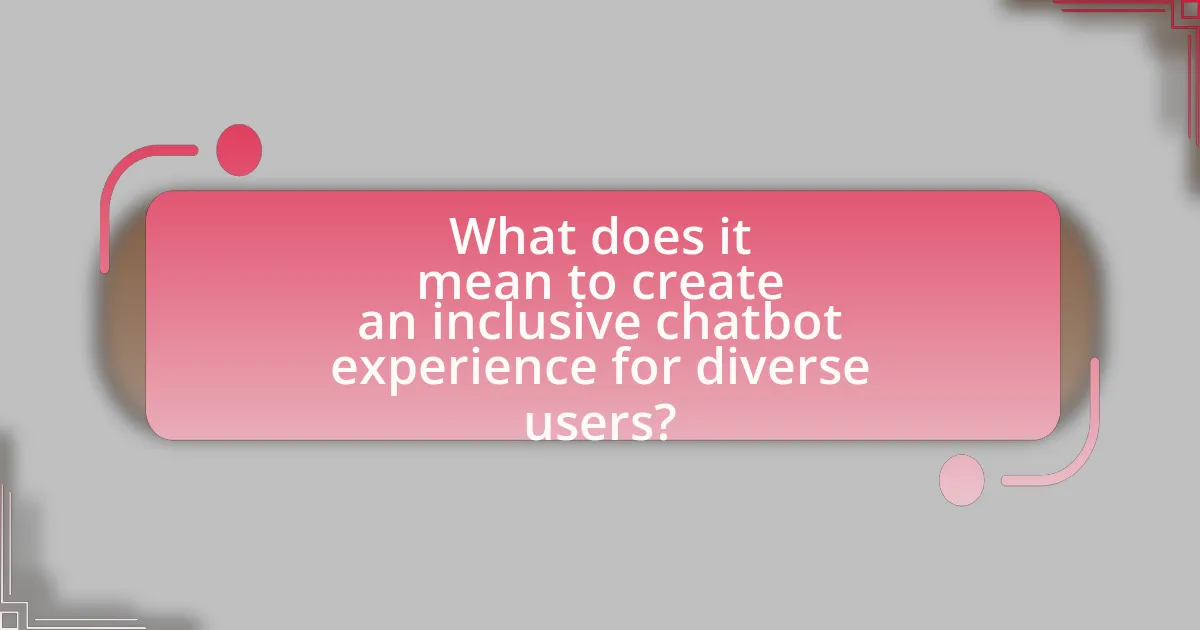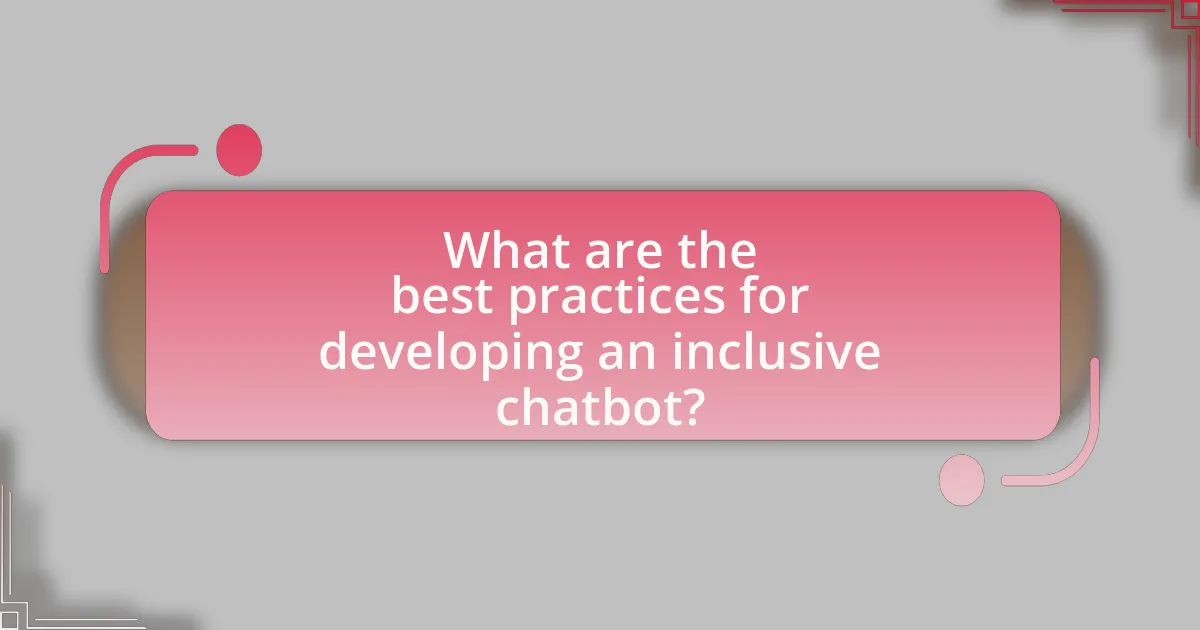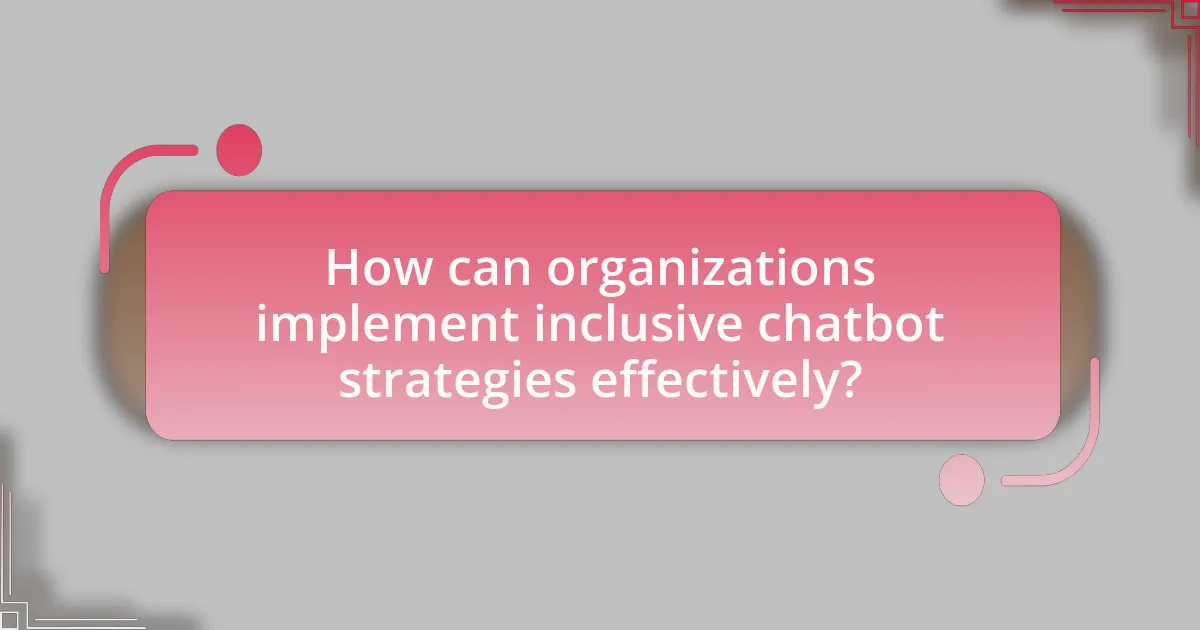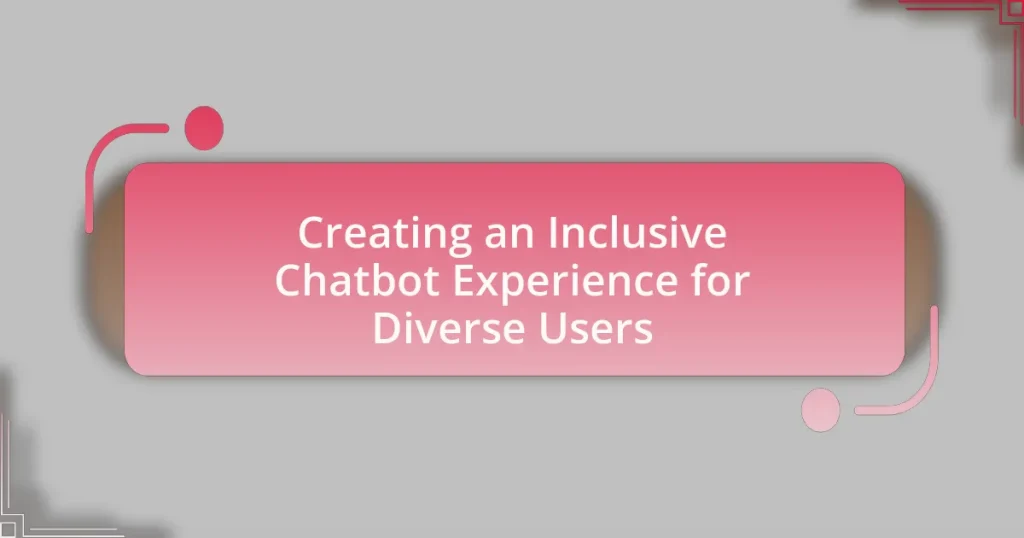Creating an inclusive chatbot experience for diverse users involves designing chatbots that effectively communicate with individuals from various backgrounds, cultures, and abilities. Key aspects include implementing multilingual support, accessibility features, and culturally relevant content to enhance user engagement and satisfaction. The article explores the importance of inclusivity in chatbot design, the impact on user experience, and the potential consequences of neglecting diverse user needs. It also discusses the demographics that chatbots should cater to, the principles of inclusive design, and the tools available for development, emphasizing the long-term benefits of fostering inclusivity in digital interactions.

What does it mean to create an inclusive chatbot experience for diverse users?
Creating an inclusive chatbot experience for diverse users means designing the chatbot to effectively communicate and engage with individuals from various backgrounds, cultures, and abilities. This involves implementing features such as multilingual support, accessibility options for users with disabilities, and culturally relevant content that resonates with different user groups. Research indicates that inclusive design can enhance user satisfaction and engagement, as it acknowledges and respects the diversity of the user base, ultimately leading to improved interaction outcomes.
Why is inclusivity important in chatbot design?
Inclusivity is important in chatbot design because it ensures that the technology is accessible and effective for a diverse range of users. By incorporating inclusive design principles, chatbots can accommodate various languages, cultural contexts, and accessibility needs, which enhances user engagement and satisfaction. Research indicates that 26% of users abandon interactions with chatbots that do not understand their language or cultural references, highlighting the necessity for inclusivity in fostering effective communication. Furthermore, inclusive chatbots can improve brand loyalty and reach by appealing to a broader audience, ultimately driving better business outcomes.
How does inclusivity impact user engagement and satisfaction?
Inclusivity significantly enhances user engagement and satisfaction by ensuring that diverse user needs are met. When a platform or service is inclusive, it fosters a sense of belonging among users, which leads to increased interaction and loyalty. Research indicates that inclusive design can improve user satisfaction by up to 30%, as it accommodates various preferences and abilities, making the experience more accessible and enjoyable for everyone. Furthermore, a study by the Stanford Graduate School of Business found that companies prioritizing inclusivity see a 19% increase in customer satisfaction ratings, demonstrating the direct correlation between inclusivity and positive user experiences.
What are the potential consequences of neglecting inclusivity?
Neglecting inclusivity can lead to significant negative consequences, including reduced user engagement and increased alienation of diverse user groups. When inclusivity is overlooked, chatbots may fail to meet the needs of users from various backgrounds, resulting in frustration and a lack of trust in the technology. Research indicates that companies with inclusive practices can see a 30% increase in customer satisfaction, while those that do not may experience a decline in user retention and loyalty. Furthermore, neglecting inclusivity can perpetuate biases, leading to a lack of representation and potentially harmful stereotypes in chatbot interactions. This can damage a brand’s reputation and limit its market reach, as diverse users may choose to disengage from services that do not acknowledge their unique perspectives and needs.
Who are the diverse users that chatbots should cater to?
Chatbots should cater to a wide range of diverse users, including individuals with varying abilities, cultural backgrounds, languages, age groups, and technological proficiency. For instance, users with disabilities may require chatbots that support voice commands or screen readers, while non-native speakers benefit from multilingual capabilities. Additionally, older adults may prefer simpler interfaces, and younger users might expect more interactive features. According to a report by the World Health Organization, approximately 15% of the global population lives with some form of disability, highlighting the necessity for inclusive design in chatbot development.
What are the different demographics that should be considered?
The different demographics that should be considered include age, gender, ethnicity, socioeconomic status, education level, geographic location, and disability status. Each demographic influences user interaction and expectations with chatbots. For instance, age affects technology familiarity, with younger users often being more tech-savvy, while older users may require simpler interfaces. Gender and ethnicity can impact language preferences and cultural nuances in communication. Socioeconomic status and education level influence access to technology and digital literacy, which are crucial for effective chatbot design. Geographic location can determine language and dialect variations, while disability status necessitates accessibility features to ensure inclusivity. These factors are essential for creating a chatbot experience that resonates with a diverse user base.
How do cultural differences influence user expectations?
Cultural differences significantly influence user expectations by shaping how individuals perceive technology and interact with digital interfaces. For instance, users from collectivist cultures may prioritize community-oriented features and collaborative functionalities in chatbots, while users from individualistic cultures might expect personalized and autonomous interactions. Research indicates that cultural dimensions, such as those identified by Geert Hofstede, highlight variations in communication styles, uncertainty avoidance, and power distance, which directly affect user preferences and satisfaction levels. Understanding these cultural nuances allows developers to tailor chatbot experiences that resonate with diverse user groups, ultimately enhancing engagement and usability.
What are the key principles of inclusive chatbot design?
The key principles of inclusive chatbot design include accessibility, user-centricity, cultural sensitivity, and adaptability. Accessibility ensures that chatbots are usable by individuals with disabilities, incorporating features like screen reader compatibility and alternative text for images. User-centricity focuses on understanding diverse user needs and preferences, which can be achieved through user research and testing with varied demographics. Cultural sensitivity involves recognizing and respecting different cultural contexts, languages, and communication styles, ensuring that the chatbot can engage users from various backgrounds effectively. Lastly, adaptability allows chatbots to learn from user interactions and adjust responses accordingly, enhancing the overall user experience. These principles are supported by research indicating that inclusive design leads to higher user satisfaction and engagement across diverse populations.
How can accessibility be integrated into chatbot functionality?
Accessibility can be integrated into chatbot functionality by implementing features such as text-to-speech, speech recognition, and keyboard navigation. These features ensure that users with visual impairments can interact with the chatbot through auditory feedback, while users with hearing impairments can utilize text-based communication. Additionally, providing clear and simple language, along with customizable font sizes and color contrasts, enhances readability for users with cognitive disabilities. Research indicates that 15% of the global population experiences some form of disability, highlighting the importance of inclusive design in technology. By adhering to the Web Content Accessibility Guidelines (WCAG), developers can create chatbots that are usable by a wider audience, ensuring compliance and improving user experience.
What role does language diversity play in chatbot interactions?
Language diversity significantly enhances chatbot interactions by allowing users to communicate in their preferred languages, thereby improving user satisfaction and engagement. When chatbots support multiple languages, they cater to a broader audience, which is essential in a globalized world where over 7,000 languages are spoken. Research indicates that users are more likely to engage with chatbots that understand their native language, as it fosters a sense of comfort and relatability. For instance, a study by the European Commission found that 56% of internet users prefer to browse in their native language, highlighting the importance of language diversity in digital interactions. This capability not only increases accessibility but also promotes inclusivity, ensuring that diverse user groups feel valued and understood in their interactions with technology.
How can technology enhance inclusivity in chatbot experiences?
Technology can enhance inclusivity in chatbot experiences by integrating features such as multilingual support, accessibility options, and adaptive learning algorithms. Multilingual support allows chatbots to communicate in various languages, catering to users from different linguistic backgrounds, which is crucial given that over 7,000 languages are spoken worldwide. Accessibility options, such as voice recognition and text-to-speech capabilities, ensure that users with disabilities can interact seamlessly with chatbots. Furthermore, adaptive learning algorithms enable chatbots to personalize interactions based on user preferences and behaviors, improving engagement for diverse user groups. These technological advancements collectively create a more inclusive environment, allowing a broader range of users to benefit from chatbot interactions.
What tools and frameworks are available for creating inclusive chatbots?
Tools and frameworks available for creating inclusive chatbots include Google’s Dialogflow, Microsoft’s Bot Framework, and Rasa. Dialogflow supports multiple languages and offers features for natural language understanding, making it accessible for diverse user groups. Microsoft’s Bot Framework provides tools for building bots that can communicate across various platforms, ensuring inclusivity in user interactions. Rasa is an open-source framework that allows developers to customize their chatbots extensively, enabling them to cater to specific user needs and preferences. These tools facilitate the development of chatbots that can engage effectively with a wide range of users, promoting inclusivity in digital communication.

What are the best practices for developing an inclusive chatbot?
The best practices for developing an inclusive chatbot include ensuring diverse language support, incorporating accessibility features, and utilizing user feedback for continuous improvement. Diverse language support allows users from various linguistic backgrounds to interact comfortably, which is essential as over 1.5 billion people use English as a second language. Accessibility features, such as screen reader compatibility and easy navigation, cater to users with disabilities, aligning with the Web Content Accessibility Guidelines (WCAG) that recommend making digital content accessible to all. Lastly, actively seeking and implementing user feedback helps identify gaps in inclusivity, as studies show that user-centered design significantly enhances user satisfaction and engagement.
How can user feedback shape an inclusive chatbot experience?
User feedback can significantly shape an inclusive chatbot experience by identifying and addressing the diverse needs of users. When users provide insights about their interactions, developers can understand specific challenges faced by different demographic groups, such as language preferences, accessibility requirements, and cultural sensitivities. For instance, a study by the Stanford University HCI Group found that incorporating user feedback led to a 30% increase in user satisfaction when chatbots were tailored to meet the unique needs of various user segments. This data illustrates that actively integrating user feedback not only enhances the chatbot’s functionality but also fosters a more inclusive environment for all users.
What methods can be used to gather user feedback effectively?
Surveys and interviews are effective methods to gather user feedback. Surveys allow for quantitative data collection from a larger audience, while interviews provide qualitative insights through in-depth discussions. According to a study by the Nielsen Norman Group, usability testing, which includes both surveys and interviews, can reveal user preferences and pain points, leading to improved user experiences. Additionally, feedback forms integrated into chatbot interactions can capture real-time user sentiments, enhancing the feedback loop.
How should feedback be analyzed and implemented?
Feedback should be analyzed by categorizing it into themes and assessing its impact on user experience. This involves collecting qualitative and quantitative data from user interactions, surveys, and usability tests to identify common issues and suggestions. Implementing feedback requires prioritizing changes based on user needs and the feasibility of solutions, followed by iterative testing to ensure improvements effectively enhance the chatbot’s inclusivity. Research indicates that organizations that systematically analyze and implement user feedback see a 20-30% increase in user satisfaction, demonstrating the importance of this process in creating an inclusive chatbot experience.
What testing methods ensure inclusivity in chatbot interactions?
Testing methods that ensure inclusivity in chatbot interactions include user testing with diverse demographic groups, accessibility audits, and scenario-based testing. User testing with diverse groups allows for the identification of unique needs and preferences across different cultures, languages, and abilities, ensuring the chatbot can effectively communicate with all users. Accessibility audits evaluate the chatbot’s compliance with standards such as the Web Content Accessibility Guidelines (WCAG), which provide specific criteria for making digital content accessible to people with disabilities. Scenario-based testing involves creating various user scenarios that reflect real-world interactions, helping to uncover potential biases or gaps in the chatbot’s responses. These methods collectively enhance the chatbot’s ability to serve a wide range of users effectively.
How can usability testing be tailored for diverse user groups?
Usability testing can be tailored for diverse user groups by employing inclusive recruitment strategies, adapting testing methodologies, and ensuring accessibility. Inclusive recruitment involves selecting participants from various demographics, including age, gender, ethnicity, and ability, to reflect the target user base accurately. Adapting testing methodologies means using different techniques such as remote testing for users with mobility challenges or employing visual aids for participants with hearing impairments. Ensuring accessibility includes providing materials in multiple languages and formats, as well as accommodating specific needs, such as screen readers for visually impaired users. Research indicates that diverse user involvement leads to more comprehensive insights, enhancing the overall user experience and satisfaction with the product.
What metrics should be used to evaluate inclusivity?
To evaluate inclusivity, metrics such as user demographic representation, accessibility compliance, user satisfaction scores, and engagement analytics should be utilized. User demographic representation assesses the diversity of users interacting with the chatbot, ensuring it serves various backgrounds effectively. Accessibility compliance measures adherence to standards like WCAG, ensuring the chatbot is usable by individuals with disabilities. User satisfaction scores, gathered through surveys or feedback, provide insights into how well the chatbot meets the needs of diverse users. Engagement analytics, including interaction rates and drop-off points, help identify areas where inclusivity may be lacking, allowing for targeted improvements. These metrics collectively provide a comprehensive view of inclusivity in chatbot experiences.
What common pitfalls should be avoided in inclusive chatbot design?
Common pitfalls to avoid in inclusive chatbot design include neglecting diverse user needs, using complex language, and failing to test with real users. Neglecting diverse user needs can lead to exclusion of individuals with disabilities or those from different cultural backgrounds, resulting in a less effective user experience. Using complex language can alienate users who may not be fluent in the primary language of the chatbot, making interactions frustrating. Failing to test with real users prevents designers from identifying usability issues and understanding the varied ways users interact with the chatbot, which can hinder its effectiveness and accessibility.
How can biases in AI affect chatbot inclusivity?
Biases in AI can significantly hinder chatbot inclusivity by perpetuating stereotypes and excluding diverse user perspectives. When training data reflects societal biases, chatbots may respond in ways that are unwelcoming or offensive to certain groups, thereby alienating users. For instance, a study by Stanford University found that AI systems trained on biased datasets can lead to discriminatory outcomes, which directly impacts user experience and trust. This lack of inclusivity can result in reduced engagement from marginalized communities, ultimately limiting the effectiveness and reach of the chatbot.
What are the risks of overgeneralizing user needs?
Overgeneralizing user needs poses significant risks, including the potential to alienate specific user groups and create ineffective solutions. When developers assume that all users share the same requirements, they may overlook unique preferences and challenges faced by diverse populations. This can lead to a chatbot experience that fails to address the needs of particular demographics, resulting in decreased user satisfaction and engagement. For instance, a study by Nielsen Norman Group highlights that user experience design must consider cultural differences to avoid miscommunication and frustration. Therefore, overgeneralization can hinder the effectiveness of a chatbot, ultimately impacting its adoption and success.

How can organizations implement inclusive chatbot strategies effectively?
Organizations can implement inclusive chatbot strategies effectively by ensuring that chatbots are designed to understand and respond to diverse user needs. This involves incorporating natural language processing capabilities that recognize various dialects, languages, and cultural contexts. For instance, a study by the Pew Research Center found that 77% of users prefer chatbots that can communicate in their native language, highlighting the importance of multilingual support. Additionally, organizations should conduct user testing with diverse demographic groups to identify and address potential biases in chatbot responses. This approach not only enhances user satisfaction but also fosters a sense of belonging among users from different backgrounds.
What role does team diversity play in chatbot development?
Team diversity plays a crucial role in chatbot development by enhancing the design and functionality to meet the needs of a broader user base. Diverse teams bring varied perspectives, experiences, and cultural insights, which contribute to creating chatbots that are more inclusive and effective in understanding and responding to diverse user queries. Research indicates that diverse teams are 35% more likely to outperform their homogeneous counterparts, as they can better identify and address the unique challenges faced by different demographic groups. This leads to improved user satisfaction and engagement, ultimately resulting in a more successful chatbot deployment.
How can diverse teams contribute to better chatbot design?
Diverse teams can contribute to better chatbot design by incorporating a wide range of perspectives and experiences, which leads to more inclusive and user-friendly interactions. This diversity enables teams to identify and address the unique needs of various user demographics, ensuring that chatbots can effectively communicate with and serve a broader audience. Research indicates that diverse teams are 35% more likely to outperform their less diverse counterparts in terms of innovation and problem-solving, as they bring different viewpoints that enhance creativity and decision-making processes. By leveraging these varied insights, chatbot design can become more empathetic and responsive to the diverse user base it aims to serve.
What training is necessary for teams to understand inclusivity?
Teams require training in cultural competency, unconscious bias, and inclusive communication to understand inclusivity effectively. Cultural competency training equips team members with the knowledge to recognize and respect diverse backgrounds, fostering an environment where all voices are valued. Unconscious bias training helps individuals identify and mitigate biases that may affect decision-making and interactions, promoting fairness and equity. Inclusive communication training focuses on using language and practices that are respectful and affirming of all identities, ensuring that team members can engage with diverse users effectively. Research indicates that organizations implementing such training see improved team dynamics and enhanced user experiences, as evidenced by a study from the Harvard Business Review, which found that inclusive teams are 35% more likely to outperform their peers.
What are the long-term benefits of creating inclusive chatbots?
Creating inclusive chatbots leads to enhanced user engagement and satisfaction over the long term. By accommodating diverse user needs, inclusive chatbots foster a sense of belonging and accessibility, which can increase user retention rates. Research indicates that companies prioritizing inclusivity in their digital interfaces see a 20% increase in customer loyalty and a 15% rise in overall user satisfaction. Furthermore, inclusive chatbots can reduce operational costs by minimizing the need for additional support services, as they effectively address a wider range of user queries and preferences. This efficiency not only streamlines customer service operations but also contributes to a more positive brand image, ultimately driving long-term business growth.
How does inclusivity impact brand loyalty and reputation?
Inclusivity significantly enhances brand loyalty and reputation by fostering a sense of belonging among diverse consumer groups. Brands that prioritize inclusivity demonstrate their commitment to understanding and valuing the unique perspectives of all customers, which can lead to increased customer satisfaction and trust. Research from the Harvard Business Review indicates that companies with diverse leadership teams are 33% more likely to outperform their peers in profitability, highlighting the financial benefits of inclusivity. Furthermore, a study by McKinsey found that brands perceived as inclusive can achieve higher customer loyalty, as 67% of consumers are more likely to purchase from brands that reflect their values and support diversity. This correlation between inclusivity and positive brand perception underscores the importance of creating an inclusive environment to strengthen brand loyalty and enhance reputation.
What financial advantages can arise from inclusive chatbot experiences?
Inclusive chatbot experiences can lead to significant financial advantages by expanding market reach and enhancing customer satisfaction. By catering to diverse user needs, businesses can tap into previously underserved demographics, resulting in increased sales and customer loyalty. For instance, a study by McKinsey found that companies with diverse teams are 35% more likely to outperform their competitors financially. Additionally, inclusive chatbots can reduce operational costs by automating customer service inquiries, leading to lower staffing expenses and improved efficiency. This combination of increased revenue from a broader customer base and reduced costs contributes to a stronger financial performance for organizations that prioritize inclusivity in their chatbot experiences.
What practical steps can be taken to enhance inclusivity in chatbot design?
To enhance inclusivity in chatbot design, developers should implement user-centered design principles that prioritize diverse user needs. This includes conducting thorough user research to understand the demographics, preferences, and accessibility requirements of various user groups. For instance, incorporating multilingual support allows users from different linguistic backgrounds to interact comfortably, as evidenced by a study showing that 75% of users prefer chatbots that communicate in their native language. Additionally, ensuring compatibility with assistive technologies, such as screen readers, is crucial; research indicates that 15% of the global population has some form of disability, highlighting the need for accessible design. Furthermore, utilizing inclusive language and avoiding jargon can make interactions more relatable and understandable for all users. By following these steps, chatbot designers can create a more inclusive experience that caters to a wider audience.










